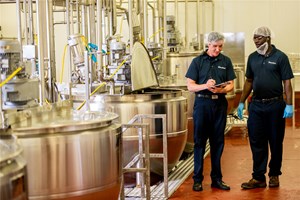Sign up to be notified of our new blog posts.
How to Improve Operator Safety in Your Food Processing Operations
Posted on March 21, 2018

Summary:
- What safety risks should be considered in food processing with kettles?
- How do kettle modifications like lift assists, grates, and insulation improve safety?
- What discharge options minimize burn risks for operators?
What Safety Issues Should Be Considered During Food Processing?
During food processing, the safety of your production team is key. Some safety issues to consider are:
- How heavy are the loads of individual ingredients in the batch?
- How high must ingredients be lifted by the operator?
- How many times must the operator open and close the kettle during a typical batch process, and what operations do they need to perform during these steps?
Power-assisted loaders and automatic fillers can be used to prevent operator injury when loading batch ingredients. Other kettle modifications that can greatly enhance safety for the operator are:
- Hinge-cover lift assists
- Cover grates
- Motor cutoff safety switches
- Variable-frequency drives
How Do Hinge-Cover Lift Assists Help Operators?
Lift assists allow the operator to easily open and close heavy kettle lids before, during and after processing. This feature also prevents the operator from getting injured from the kettle lid falling back unexpectedly onto the top of the kettle.
Why Use Cover Grates for Kettle Safety?
A grate positioned under the cover allows for visual inspection of the batch during the mixing and cooking process. It also allows for operators to safely add ingredients while the agitator is operating, without concern for hands and arms entering the kettle.
What Do Motor Cutoff Safety Switches Do?
Motor cutoff safety switches automatically turn the agitator off if the cover or grate is lifted from the kettle.
How Do Variable Frequency Drives (VFDs) Improve Safety?
With a variable frequency drive, when obstructions or heavy motor loads cause amperage spikes in the motor, the agitator motor will shut off.
How Can You Prevent Burns from Hot Kettle Surfaces?
During the cooking process, another concern is that the outside of the kettle jacket can become dangerously hot.
To protect operators who are working around the kettles from burns, kettle jacket insulation is an available option to help reduce the temperature on the outside to a safe level.
Jacket insulation also improves heat loss and improves cooking efficiency. And an added benefit is the reduction in room temperature in the plant.
What’s the Safest Way to Discharge Heated Product?
Finally, consideration should be taken when discharging the heated product at the end of the process.
Extension handles can be installed on sanitary ball valves to prevent operators from having to bend down or move underneath the kettle.
For even greater safety, pneumatically actuated sanitary ball valves can be used to provide remote operation.
To learn more about kettle design and configuration to optimize safety, download our Optimizing and Expanding Guide.
Frequently Asked Questions (FAQ)
Q: What safety features help prevent burns during kettle operation?
A: Kettle jacket insulation significantly reduces exterior surface temperature, helping protect nearby operators from accidental burns.
Q: How do motor cutoff switches protect workers?
A: They automatically disable the agitator when the grate or lid is opened, preventing contact with moving parts.
Q: Can safety features like these be retrofitted to existing equipment?
A: Yes, many of these options (like lift assists or extension valve handles) can be added to your current system.
Last Updated: 10/13/2025
Comments
John
4:42 PM on April 4, 2018